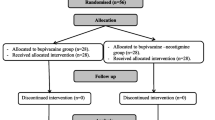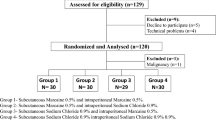Abstract
Background
This study aimed to evaluate the optimal timing of preemptive analgesia with bupivacaine peritoneal instillation in a prospective, randomized, double-blind, placebo-controlled trial.
Methods
In this study, 120 patients qualified for laparoscopic cholecystectomy were randomized to four groups. Group A received 2 mg/kg of bupivacaine in 200 ml of normal saline before creation of pneumoperitoneum. Group B received 2 mg/kg of bupivacaine in 200 ml of normal saline after creation of pneumoperitoneum. Group C received 200 ml of normal saline before creation of pneumoperitoneum. Group D received 200 ml of normal saline after creation of pneumoperitoneum. Local wound infiltration with bupivacaine was used before skin incisions. The primary end points of the study were postoperative pain intensity on a visual analog scale and incidence of shoulder tip pain. The secondary end points included the latency of nurse-controlled analgesia activation, the analgesia request rate, and analgesic consumption.
Results
Significantly lower visual analog scores were observed in group A versus groups C and B versus group D during the initial 48 and 24 h, respectively. The patients in group A versus group B reported significantly lower pain at 4 h (p < 0.001) and 8 h (p = 0.003) postoperatively, but the difference was not significant after 12, 24, and 48 h. None of the group A patients reported shoulder tip pain, whereas it was reported by 3 patients in group B, 6 patients in group C, and 7 patients in group D (p < 0.01). The latency of nurse-controlled analgesia activation was 426.8 ±57.2 min in group A, as compared with 307 ± 39.8 min in group B, 109.3 ± 51 min in group C, and 109 ± 46.5 min in group D (p < 0.001). A significantly lower analgesia request rate was observed in group A versus C, as compared with group B versus D, throughout the entire study period (p < 0.05).
Conclusions
Preemptive analgesia with bupivacaine peritoneal instillation is much more effective for pain relief if used before creation of pneumoperitoneum. Although the effect of bupivacaine peritoneal instillation is also noticeable when used after creation of pneumoperitoneum, it confers significantly lower benefits.

Similar content being viewed by others
References
Barczyński M, Herman RM (2003) A prospective randomized trial on comparison of low-pressure (LP) and standard-pressure (SP) pneumoperitoneum for laparoscopic cholecystectomy. Surg Endosc 17: 533–538
Barczyński M, Herman RM (2004) Low-pressure pneumoperitoneum combined with intraperitoneal saline washout for reduction of pain after laparoscopic cholecystectomy: a prospective randomized study. Surg Endosc 18: 1368–1373
Bisgaard T, Klarskov B, Kehlet H, Rosenber J (2003) Preoperative dexamethasone improves surgical outcome after laparoscopic cholecystectomy: a randomized double-blind placebo-controlled trial. Ann Surg 238: 651–660
Bisgaard T, Klarskov B, Kristiansen VB, Callesen T, Schulze S, Kehlet H, Rosenber J (1999) Multiregional local anesthetic infiltration during laparoscopic cholecystectomy in patients receiving prophylactic multimodal analgesia: a randomized, double-blind, placebo-controlled study. Anesth Analg 89: 1017–1024
Cervini P, Smith LC, Urbach DR (2002) The effect of intraoperative bupivacaine administration on parenteral narcotic use after laparoscopic appendectomy. Surg Endosc 16: 1579–1582
Cunniffe MG, McAnena OJ, Dar MA, Calleary J, Flynn N (1998) A prospective randomized trial of intraoperative bupivacaine irrigation for management of shoulder tip pain following laparoscopy. Am J Surg 176: 258–261
Elfberg BA, Sjövall-Mjöberg S (2000) Intraperitoneal bupivacaine does not effectively reduce pain after laparoscopic cholecystectomy: a randomized, placebo-controlled and double-blind study. Surg Laparosc Endosc 6: 357–359
Elhakim M, Elkott M, Alin NM, Tahoun HM (2000) Intraperitoneal lidocaine for postoperative pain after laparoscopy. Acta Anaesthesiol Scand 44: 280–284
Fletcher D, Kayser V, Guilbaud G (1996) Influence of timing of administration on the analgesic effect of bupivacaine infiltration in carrageenin-injected rats. Anaesthesiology 84: 1129–1137
Gharaibeh KI, Al-Jaberi TM (2000) Bupivacaine instillation into gallbladder bed after laparoscopic cholecystectomy: does it decrease shoulder pain? J Laparoendosc Adv Surg Tech A 10: 137–141
Hernandez-Palazon J, Tortossa JA, Nuno de la Rosa V, Gimenez-Viudes J, Ramirez G, Robles R (2003) Intraperitoneal application of bupivacaine plus morphine for pain relief after laparoscopic cholecystectomy. Eur J Anaestesiol 20: 891–896
Maestroni U, Sarli D, Devito C, Pour Morard Kohan Brunaldi F, Anania G, Pavanelli L, Pasqualucci A, Donini A (2002) A new method of preemptive analgesia in laparoscopic cholecystectomy. Surg Endosc 16: 1336–1340
Mouton WG, Bessell JR, Otten KT, Maddern GJ (1999) Pain after laparoscopy. Surg Endosc 13: 445–448
Ng A, Smith G (2002) Intraperitoneal administration of analgesia: is this practice of any utility? Br J Anaesth 89: 535–537
Ng A, Swami A, Smith G, Robertson G, Lloyd DM (2004) Is intraperitoneal levobupivacaine with epinephrine useful for analgesia following laparoscopic cholecystectomy? A randomized controlled trial. Eur J Anaesthesiol 21: 653–657
O’Hanlon DM, Colbert S, Ragheb J, McEntee GP, Chambers F, Moriarty DC (2002) Intraperitoneal pethidine versus intramuscular pethidine for the relief of pain after laparoscopic cholecystectomy: randomized trial. World J Surg 26: 1432–1436
Papagiannopoulou P, Argiriadou H, Georgius M, Papaziogas B, Sfyra E, Kanakoudis F (2003) Preincisional local infiltration of levobupivacaine vs ropivacaine for pain control after laparoscopic cholecystectomy. Surg Endosc 17: 1961–1964
Pascqualucci A, De Angelis V, Contardo R, Colo F, Terrosu G, Donini A, Pasetto A, Bresadola F (1996) Preemptive analgesia: A randomized, double-blind, placebo-controlled study. Anesthesiology 85: 11–20
Scheinin B, Kellokumpu I, Lindgren L, Haglund C, Rosenberger PH (1995) Effect of intraperitoneal bupivacaine on pain after laparoscopic cholecystectomy. Acta Anaesthesiol Scand 39: 195–198
Szem JW, Hydo L, Barie PS (1996) A double-blinded evaluation of intraperitoneal bupivacaine vs saline for the reduction of postoperative pain and nausea after laparoscopic cholecystectomy. Surg Endosc 10: 44–48
Tsimoyiannis EC, Glantzounis G, Lakkas ET, Siakas P, Jabarin M, Tzourou H (1998) Intraperitoneal normal saline and bupivacaine infusion for reduction of postoperative pain after laparoscopic cholecystectomy. Surg Laparosc Endosc 8: 416–420
Ure BM, Troidl H, Spangenberger W, Neugebauer E, Lefering R, Ullmann K, Bende J (1993) Preincisional local anesthesia with bupivacaine and pain after laparoscopic cholecystectomy: a double-blind randomized clinical trial. Surg Endosc 7: 482–488
Weber A, Munoz J, Garteiz D, Cueto J (1997) Use of subdiaphragmatic bupivacaine instillation to control postoperative pain after laparoscopic surgery. Surg Laparosc Endosc 7: 6–8
Wills VL, Hunt DR (2000) Pain after laparoscopic cholecystectomy. Br J Surg 87: 273–284
Wnęk W, Zajączkowska R, Wordliczek J, Dobrogowski J, Korbut R (2004) Influence of preoperative ketoprofen administration (preemptive analgesia) on analgesic requirement and the level of prostaglandins in the early postoperative period. Pol J Pharmacol 56: 547–552
Woolf CJ, Mannion RJ (1999) Neuropathic pain: aethiology, symptoms, mechanisms, and management. Lancet 353: 1959–1964
Wordliczek J, Banach M, Garlicki J, Jakowicka-Wordliczek J, Dobrogowski J (2002) Influence of pre- or intraoperational use of tramadol (preemptive or preventive analgesia) on tramadol requirement in the early postoperative period. Pol J Pharmacol 54: 693–697
Author information
Authors and Affiliations
Corresponding author
Additional information
The initial results were presented at the 12th International Congress of the European Association for Endoscopic Surgery (EAES), 9–12 June 2004, Barcelona, Spain, and awarded the Karl Storz EAES Prize. The final results were presented at the 13th International Congress of the European Association for Endoscopic Surgery (EAES), 1–4 June 2005, Venice, Italy.
Rights and permissions
About this article
Cite this article
Barczyński, M., Konturek, A. & Herman, R.M. Superiority of preemptive analgesia with intraperitoneal instillation of bupivacaine before rather than after the creation of pneumoperitoneum for laparoscopic cholecystectomy: a randomized, double-blind, placebo-controlled study. Surg Endosc 20, 1088–1093 (2006). https://doi.org/10.1007/s00464-005-0458-1
Received:
Accepted:
Published:
Issue Date:
DOI: https://doi.org/10.1007/s00464-005-0458-1




